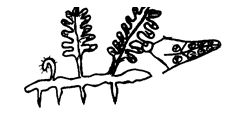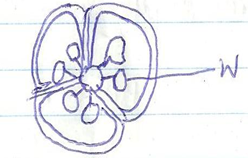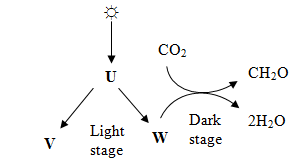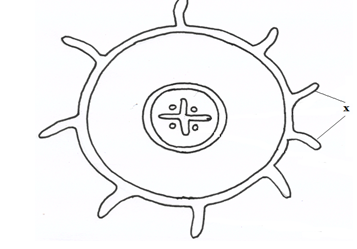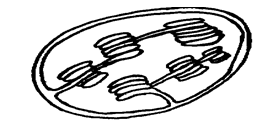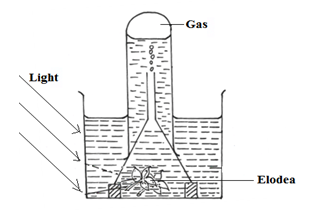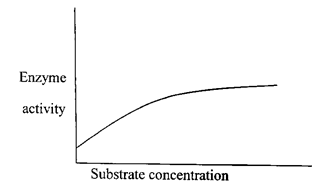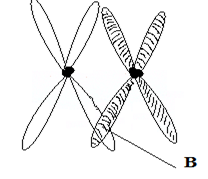- Name the branch of Biology that involves the study of: (2marks)
- Organisms for the sake of classifying them.
- Microscopic organisms.
- The diagram below represents a plant
- Name the division to which the plant belongs. (1mark)
- Give three reasons for your answer in (a) above. (3marks)
- State three parameters that can be used to estimate growth in seedlings. (3marks)
- Equal amounts of crushed Irish potato were placed in equal volumes of hydrogen peroxide solution at indicated pH. The volume of the gas produced was measured and recorded as shown in the table below.
pH
4.0
7.0
9.0
Volume of gas (cm3)
2.7
5.7
7.7
- Name the gas that was produced. (1mark)
- Account for the difference in the volume of the gas produced in pH 4.0 and pH 9.0 (2marks)
- The diagram below represents a transverse section of an ovary from a certain flower.
- Name the structure labeled W. (1mk)
- Name the type of placentation illustrated in this diagram. (1mk)
- What are the names of modified leaves enclosing bougainvillea flowers whose function is to attractinsect pollinators? (1mark)
-
- A dog weighing 15.2kg requires 216kJ while a mouse weighing 50g requires 2736 kJ per day.
Explain. (2marks - Under what condition is lactic acid formed in human muscles? (1mark)
- A dog weighing 15.2kg requires 216kJ while a mouse weighing 50g requires 2736 kJ per day.
- In a certain experiment, the following observation was made: When red blood cell was placed in a certain solution, the solution exerted more osmotic pressure leading to the cell losing water molecules to become crenated/ shrunk.
- What type of solution was the cell placed in respect to the cell’s cytoplasm? (1 mark)
- By which physiological process did the cell lose water molecules? (1 mark)
- Study the flow diagram below.
Name the substance U, V and W. (3 marks)- State the deficiency diseases of each of the following vitamins. (3 marks)
B1
B2
B6 - What is the role of roughage in a diet? (1 mark)
- State the deficiency diseases of each of the following vitamins. (3 marks)
- The diagram below represents a transverse section of a plant part. Study it and answer the questions that follow.
- Name the class in which the plant belongs. ( 1mark)
- Give a reason for answer (a) above ( 1mark)
- State one adaptation for the structures labeled X to their functions. (1mark)
- Below is a diagram of an organelle.
- State the function of the organelle drawn above. (1mark)
- Name the parts of the organelle where :
- Oxygen gas is produced as a byproduct. (1mark)
- Carbon (IV) oxide is utilized. (1mark)
- The equation below represents a metabolic process that occurs in the mammalian liver.
- Name the process (1 mark)
- What is the importance of the process to the mammal? (2marks
- The diagram below represents a set up that was used to investigate a certain process in a plant.
- State the process that was being investigated. (1 mark)
- Other than the factors shown, state two factors that would affect the process named in (a) above. ( 2 marks)
-
- Name the causal organism for amoebic dysentery. (1 mark)
- State three preventive measures of schistosomiasis in human beings (3 marks)
-
- Why is the wall of the left ventricle thicker than that of the right ventricle. (1mark)
- State three adaptations of xylem to water transportation (3marks)
- Use the graph below to answer the following questions.
- Why does the activity of the enzyme become constant after a while? (1mark)
- State how the activity of the enzyme may be increased in (a) above. (1mark)
- Describe capture - recapture method of estimating population. (3marks)
- What is meant by self sterility with reference to flowers? (1mark)
- Why do plants lack complex excretory system? (3marks)
- State three advantages of asexual reproduction in plants. (3 marks)
- How does sunken stomata help in lowering transpiration? (3marks)
- State the importance of active transport in living organisms. (3marks)
- Why does carboxyhaemoglobin lead to death? (2marks)
- Name two gaseous exchange sites in higher plants. (2marks)
- What causes apical dominance? (1mark)
-
- What type of circulatory system is found in members of class insecta? (1 mark)
- Name the blood vessel that transports blood from:
- Small intestine to liver. (1 mark)
- Lungs to heart (1 mark)
- Distinguish between natural and acquired immunity. (2 marks)
- The diagram below shows a phenomenon which occurs during cell division.
- Identify the stage of cell division in which this phenomenon occurs. (1 mark)
- State the importance of the phenomenon taking place in the part labeled B. (2 marks)
- State two functions of ovaries in humans. (2marks)

MARKING SCHEME
-
- Taxonomy;
- Microbiology
-
- Pteridophyta; (reject incorrect spelling)
- Presence of sori; rhizome; fronds;
- Surface area of leaves; height/length; dry weight / mass
-
- Oxygen;
- More gas / oxygen produced at PH 9.0 than PH 9.0 4.0; PH 9.0 is optimum / suitable for the activity of enzyme catalase;
-
-
- Ovules;
- Axile;
- Orange / Lemon/Tangerine/Lime/Tomato/Sodom apple/Thorny apple/Irish potato/Egg plant/Banana/Hibiscuss/ Apple;
-
- Bracts;
-
- A mouse has larger surface area to volume ratio; loses more energy/ heat hence needs more energy to compensate for the loss;
- Insufficient oxygen / anaerobic;
-
- Hypertonic solution;
- Osmosis;
U:Water;V:Oxygen gas; W:Hydrogen ions;
- Beri beri; (ii) Pellagra; (iii) Pernicious anaemia;
- Increases bulkiness of food in the alimentary canal to enhance peristalsis/ firm grip along lining of the canal;
-
- Dicotyledonae; (1mk)
- Centrally placed star shaped Xylem with phloem (alternatively) between the arms of the Xylem;
(b) is tied to (a) (1mk) - -Numerous/Elongated to increase surface area for absorption of water/minerals/both;
-Thin walled for faster absorption of water/mineral salts/or both;
-Numerous mitochondria to provide energy for absorption of mineral salts;
- Large sap vacuole to create high osmotic pressure;
-
- Site of photosynthesis;
-
- grana /granum;
- stroma;
-
- Deamination; (1mk)
- -Removal of excess amino acids;
-Availing energy in the body;
-Formation of glycogen/fat for storage;
(any 2 correct 1x2 =2mks)
(b) is tied to (a)
-
- Photosynthesis;
- Carbon (IV) oxide concentration; (the valency power correctly)
Temperature;
Amount of chlorophyll; (b) is tied to (a)
(Any two correct 1x2 =2mks)
- Entamoebahistolytica; (rules of Binomial nomeclacture followed) (1mk)
-
- Proper (sanitary) disposal of faeces and urine/use of deep pit latrines/flash toilets for disposal of faeces and Urine;
- All drinking water boiled/chemically treated to kill the eggs/miracidia/cercariae;
- People should not bath/swim in water infested with snails;
- People should wear protective shoes/water proof shoes/gumboots when walking in waters infested with snails/swampy areas;
- Spray water infested with snails with molluscicides;(Any first three correct 3x1 = 3mks)
-
- Pumps blood at higher pressure to longer distance.
- Lignified wall to strengthen / prevent the wall form collapsing;
Pitted wall for lateral movement of water to the adjacent cells;
-
- All active sites of enzymes are occupied;
- Increasing the concentration of enzymes / adding more enzymes;
-
- Capture the organism using appropriate means ; mark with water proof paint, count and releases; capture again after 48hrs count all, use the formula to estimate the pop;
- Inability of the pollen grains to fertilize the egg cell of the same plant
- Produce less toxic waste;
Wastes accumulate slowly;
Some waste are recycled;
-
- Beneficial characteristic are retained/ because;
- New offspring are identical to the parent;
- Organism matures faster;
- It does not depend on population/fertilization/fruit and seed dispersal;
- New plants obtain nourishment from their parent plant/ hence they can survive temporarily during unstable environmental conditions; (Any first three correct 3x1 = 3mks)
- Water vapour accumulates in stomatal pits making the environment around the stomata humid; this lowers the saturation deficit;(hence less water is lost into the atmosphere) Water vapour accumulates in the pit; ü1mk lowering saturation deficiency hence reduced rate of transpiration. ü1mk
- -Transmission of nerve impulse;
-Re- absorption of salts in kidneys;
- Excretion of nitrogenous wastes;
-Absorption of mineral salts by plants
-Translocation of food substances.
-Absorption of food substance in the ileum.
- Stable / does not dissociate ; reducing oxygen carrying of RBCs;
- - Stomata;
-Cuticle;
-Lenticels;
- Higher conc. Of auxins in the apical bud;
-
- -openü1mk ( 1mk)
-
- -Hepatic portal vein. ü1mk
- -Pulmonary vein. ü1mk
- Acquired immunity is immunity developed after suffering from a disease ü1mk or following immunization whereas natural immunity is inborn/inherited. ü1mk
-
- Prophase I ;(Reject wrong spelling/prophase 1/i)
- Recombination of genes; leading to variation; (2mks)
- Production of eggs/ova;Section of hormones;
Join our whatsapp group for latest updates
Tap Here to Download for 50/-
Get on WhatsApp for 50/-
Download BIOLOGY PAPER 1 - KCSE 2019 NYANDARUA PRE MOCK EXAMINATION.
Tap Here to Download for 50/-
Get on WhatsApp for 50/-
Why download?
- ✔ To read offline at any time.
- ✔ To Print at your convenience
- ✔ Share Easily with Friends / Students

